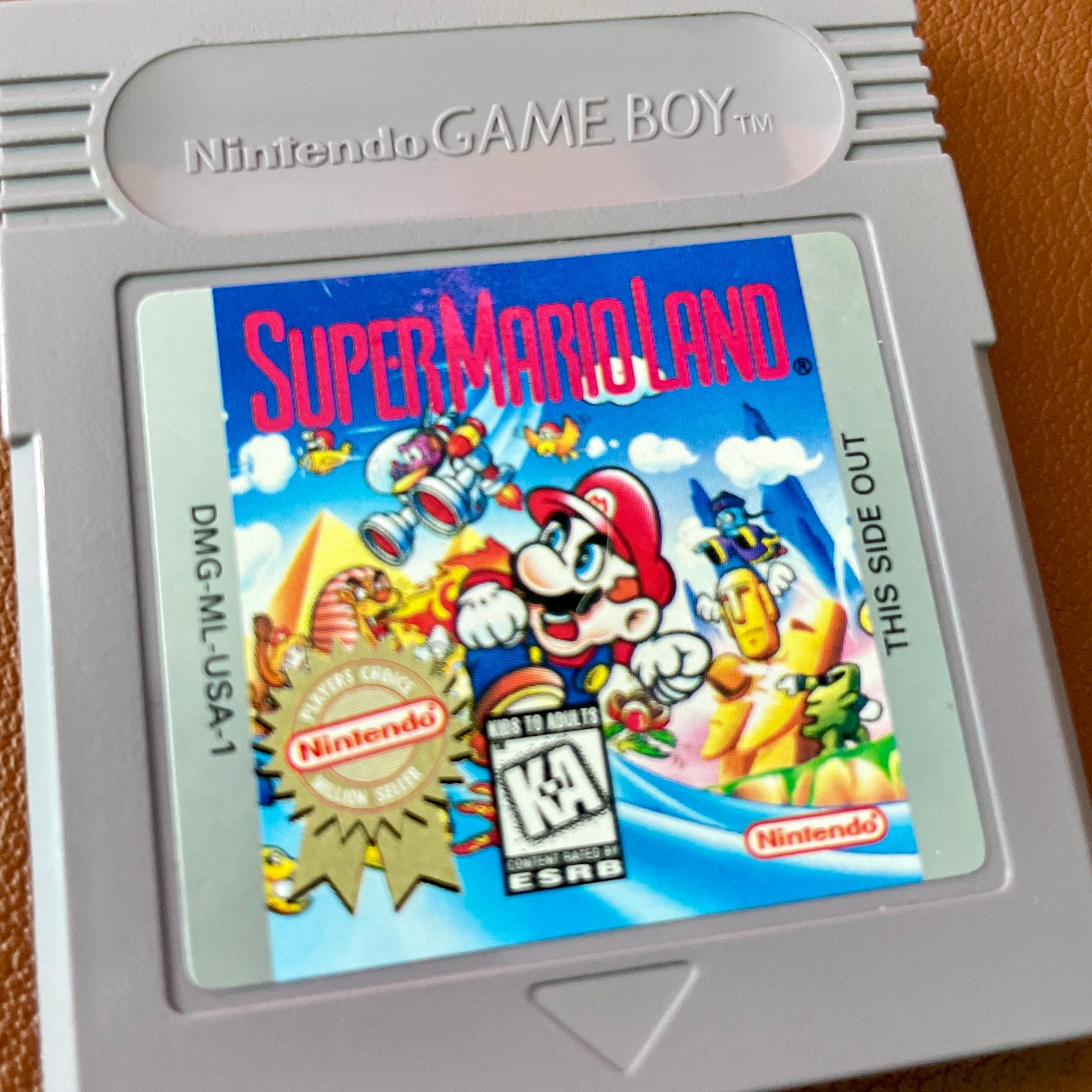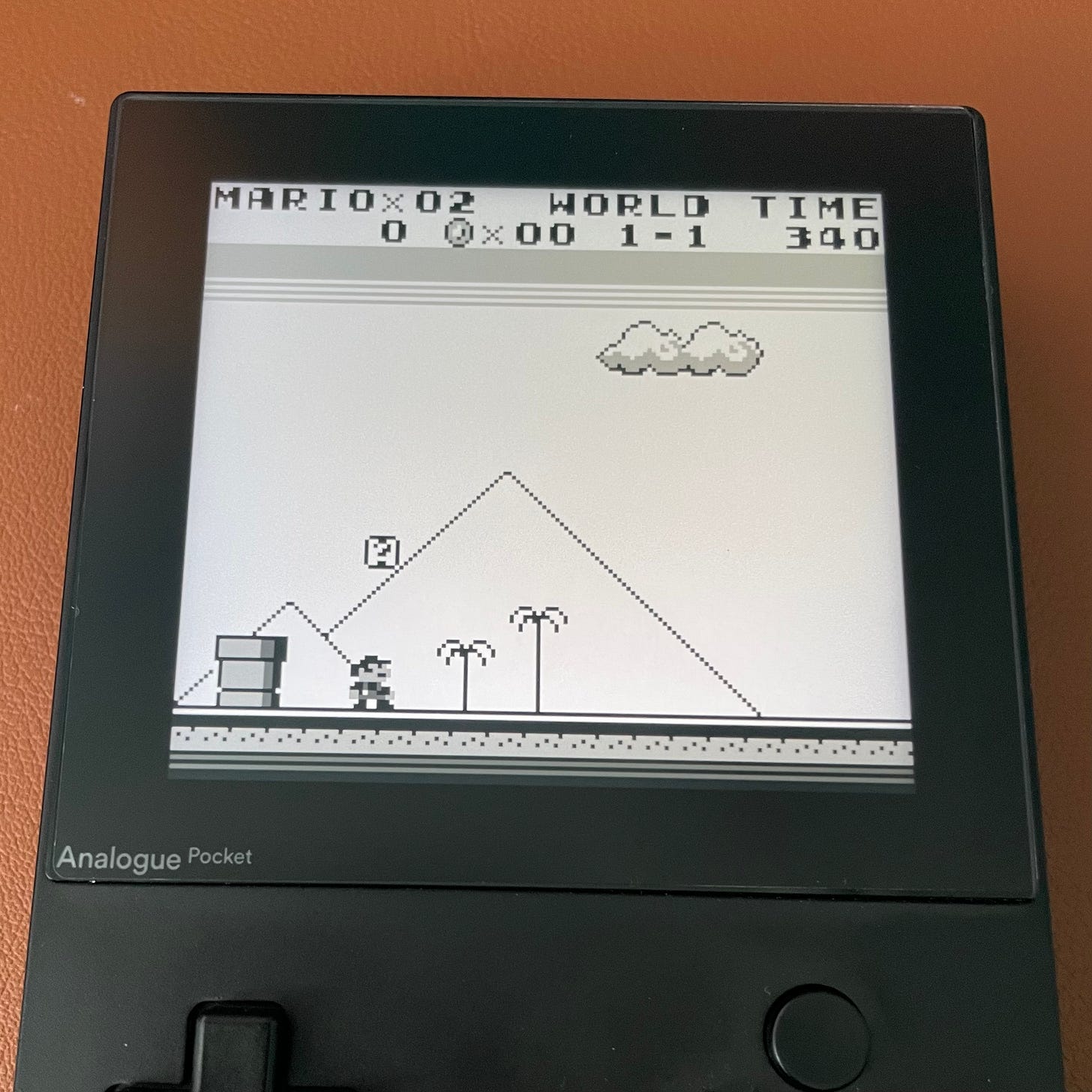Playing Super Mario Land is one of my oldest gaming memories. As a very young child, my babysitter would bring her brother’s Game Boy to keep me entertained for hours as she studied and watched television. I would sit on the floor with the Game Boy plugged into the wall through the AC adaptor to avoid devouring my parents’ precious AA batteries. It was a novelty to have a whole Mario game playable in my hands rather than begging my father to plug the NES into the television.
As an adult, playing Super Mario Land is akin to having a fever dream of playing a Mario game. There are so many oddities that set this game apart from the main Mario games that have been released for home consoles. It is the only game to take place in the never again visited world of Sarasaland; Mario’s goal this time is to rescue Princess Daisy, rather than the series mainstay Peach; and the game contains many unique gameplay elements that set it apart from the rest of the handheld and console iterations of the Mario series.
Most of Super Mario Land’s design choices make sense considering the limitations of the portable device. Many early Game Boy titles suffered due to creators not understanding the device's limitations. The original Game Boy had a dot matrix LCD limited to four shades of green vomit that suffered due to bad ghosting. Rather than series creator Shigeru Miyamoto’s team, Super Mario Land was developed by Nintendo R&D1 headed by Game Boy creator Gunpei Yokoi. The game was released alongside the launch of the Game Boy in 1989. Nintendo R&D1 was the perfect group to handle Nintendo’s most successful franchise’s transition to the Game Boy since they were also the team that engineered the device.
Super Mario Land looks fantastic for an early Game Boy release and holds up remarkably well. Mario, enemies, and platforms appear in darker shades upon a mostly empty background. This limits the confusion in determining background elements and objects that Mario can interact with. The high contrast between the background and foreground elements helps with the display on the original Game Boy hardware. Still, it also looks good on modern screens such as the Analogue Pocket, the 3DS Virtual Console, or when played on an emulator.
The story can only be gleaned from reading the manual, and it is both a typical story for a Mario game and insane. An unknown space monster, Tatanga, emerged from the clouds above Sarasaland, hypnotized its inhabitants, and kidnapped Princess Daisy in hopes of marrying her. Mario journeys across four kingdoms, consisting of three levels each, to defeat Tatanga and rescue Princess Daisy. The first kingdom, Birabuto, features an ancient Egyptian theme with pyramids dotting the background and ends with a boss fight against a Sphynx. The second kingdom, Muda, has a nautical theme, and the kingdom’s final stage features Mario in a submarine, shooting missiles at an overgrown seahorse. The third world is the strangest of all, with an Easter Island theme, featuring many enemies modeled after the Moai statues. The final kingdom, Chai, is covered in bamboo, mountains, and clouds and ends with a double boss battle as Mario flies a propellor plane that shoots projectiles against a cloud and Tatanga, the Mysterious Spaceman.
It takes some time to get comfortable with controlling Mario. The game physics are quite different from what most players have grown accustomed to across the other games in the series. Mario feels heavier, meaning he falls faster than expected and takes longer to stop when leaping from platform to platform. During my recent playthrough, I suffered several avoidable deaths due to missing platforms and sliding off ledges due to inertia. Super Mario Land is generous with checkpoints, which helps to limit the frustration felt after an accidental death. At the end of nearly every level, skilled players can earn bonus lives. Thanks to the generous bonus lives, I was never in danger of losing the game.
The music throughout the game is jaunty, upbeat, and pleasant. There is not a large variety of musical tracks, but the levels do not last long enough for the music to become stale. The oddest element of the soundtrack is that the invincibility theme from the console releases of Super Mario has been replaced with a fast version of the Can-Can. All the music in the game fills me with a great sense of nostalgia and takes me back to my youth when life was nothing but happiness and joy.
Overall, Super Mario Land is a fun, short adventure. During my most recent play-through, I completed the game in about thirty minutes, including six deaths due to mistiming jumps and falling off platforms. Today, the game should be appreciated as a piece of history and a window into a time when the technical limitations of available hardware constrained video game design. Super Mario Land was one of the best-selling games released for the Game Boy, so it is relatively easy to find at used game stores and is often inexpensive. Considering my nostalgia for the game, its historical relevance, and how well it still plays today, I strongly recommend that you purchase this game if you find it for a reasonable price.





